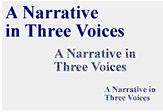
The intention is not...to name the different voices, but rather to experience some of the complexity and dissonance teachers feel....
About the narrative
“A Narrative in Three Voices” was written half way through a year in which I was exploring with my first grade students how we construct our understandings of academic literacy in our classroom. Frustrated with my inability to articulate what I was seeing going on in our daily reading group conversations, I experimented with representing both the data and the varied interpretations of them in a form that reflected the nature of classroom experiences more broadly, which entail relationship, a non-linearity, context, and conflict.
The classroom itself was situated in a large elementary school in an urban district in Northern California . The children who participated with me in the study were five- and six-year old African American students and English Language Learners. I am a white woman who had at this point taught at this school for six years. Although the narrative itself was a complete piece of writing, it was not meant to stand alone. It was rather an attempt to help make some sense of our inquiry that year. The narrative was also not meant to be read independently, but performed in a group and then engaged through conversation.
The intent in using multiple voices is to attempt to represent the fact that in teaching, data are often conflicting and that multiple interpretations can be made of the same event. The boundaries between these voices are murky, seeming at times to overlap. Part of what is being represented here is the complex and often contradictory nature of teaching. Holding conflicting emotions, interpretations, data, understandings and perceptions is part of the nature of teaching.
Were I forced to explain the differences in specific voices represented, I might call upon categories such as “observational,” “reflective,” and “exasperated.” Yet while the purpose here is to illuminate the complexity of teaching, the idea that we might strive to either reconcile these perspectives or make neat and definitive boundaries between these voices is not the purpose. Rather, this illustration of conflicting perceptions is intended to illuminate the difficulty of a teacher's coming to know and understand her students. The intention is not for the audience to name the different voices, but rather to experience some of the complexity and dissonance teachers feel as a normal part of their practice.